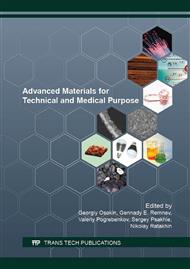p.261
p.267
p.273
p.277
p.282
p.288
p.295
p.303
p.308
Synthesis and Properties of Iron-Based Magnetic Nanoparticles
Abstract:
We have obtained magnetite nanoparticles (MNP) by using chemical coprecipitation of Fe2+ and Fe3+ in water solution. The size of these particles was less than 9 nm, and they possessed corresponding physical and chemical properties. Citric acid was used to stabilize magnetite particles suspension. The acid was affixed to the surface of the particles by adding it in fresh MNP solution during synthesis. Affixing carboxyl groups on the surface of MNP not only does improve particles' dispersion in solvent, but also allows adding further modifications to their surface. The properties of the particles' microstructure and morphology were determined with X-Ray diffraction (XRD) and transmission electron microscopy (TEM), whereas their magnetic properties were determined by means of automated pulse magnetic field analysis equipment. Magnetic measurements have shown that saturation magnetization was 94 emu/g with nanoparticles being at room temperature. We have also researched possible application of these particles as drug carriers by determining doxorubicin sorption capacity on the surface of MNPs. These MNPs have proven to have perspective ability to be a magnetic field-controlled carrier for cancer-treating drugs. The obtained particles can also potentially be used as a contrast medium for MRI.
Info:
Periodical:
Pages:
282-287
Citation:
Online since:
September 2016
Authors:
Price:
Сopyright:
© 2016 Trans Tech Publications Ltd. All Rights Reserved
Share:
Citation:


